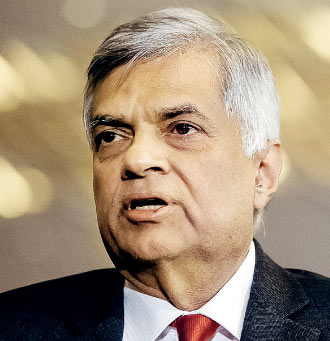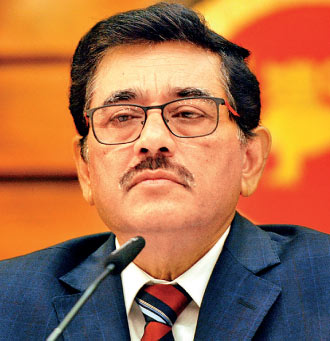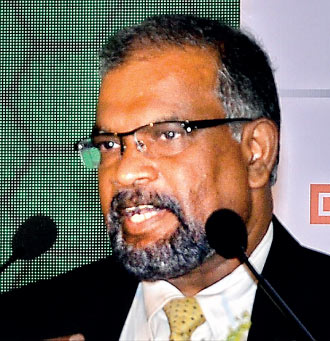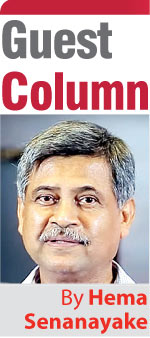Tuesday Apr 22, 2025
Tuesday Apr 22, 2025
Monday, 1 January 2024 00:11 - - {{hitsCtrl.values.hits}}

President Ranil Wickremesinghe

CBSL Governor Dr. Nandalal Weerasinghe

Treasury Secretary Mahinda Siriwardena
|
 The bottom line of economic recovery is “business confidence.” But the Governor of the Central Bank (CBSL) doesn’t agree to it, according to his own admission. In a speech telecasted by Business TV a few days ago, he said that a group of entrepreneurs and investors met with him, and they had informed that they can’t make business decisions due to the unpredictability and uncertainty of the fluctuation of interest rates, exchange rate and tax policy (you may watch the relevant part of his speech from 55.12 to 57 minute by this link https://www.youtube.com/watch?v=NQuzMqRkF8A).
The bottom line of economic recovery is “business confidence.” But the Governor of the Central Bank (CBSL) doesn’t agree to it, according to his own admission. In a speech telecasted by Business TV a few days ago, he said that a group of entrepreneurs and investors met with him, and they had informed that they can’t make business decisions due to the unpredictability and uncertainty of the fluctuation of interest rates, exchange rate and tax policy (you may watch the relevant part of his speech from 55.12 to 57 minute by this link https://www.youtube.com/watch?v=NQuzMqRkF8A).
What the entrepreneurs have said is that they do not have confidence in making business decisions due to the unpredictability of the above important parameters. The Governor did not agree with entrepreneurs; instead, he lectured them that the predictability should be in price stability or inflation not in those parameters. Therefore, he literarily informed the entrepreneurs to expect fluctuations in interest rates, exchange rate and tax policy in future. This is a completely erroneous approach and is a wrong path.
If we do not debate the philosophical understanding of the CBSL and the Government, we will be heading towards the next crash sooner rather than later. The reasoning and decisions of senior Government officials are critically important in economic governance. That may be the reason that the Supreme Court recently adjudicated that former Treasury Secretary, two Central Bank Governors and Secretary to the President have done an economic crime along with the elected political leadership of the Government.
It is true that price stability and exchange rate are two different parameters in economics. But in a country like Sri Lanka where many essential items are imported, exchange rate should be one of the main focuses of CBSL as it has influence on price stability than price stability has influence on exchange rate. Even central banks of developed economies agree that exchange rate has influence on price stability. “Exchange rates do have implications for price stability and growth.” (European Central Bank website). What they don’t do is the exchange rate devaluation for competitive purposes.
When the private credit growth increases, it tends to affect negatively to the country’s current account and if the increased deficit is not balanced off via a non-credit based inflow of dollars recorded in the Financial and Capital account in Balance of Payment account, the rupee will be depreciated rapidly and that would greatly disturb price stability. In this situation price stability is the resultant effect. However, CBSL and the Government with the advice of CBSL have certain policy tools to contain credit growth. What the entrepreneurs met with the Governor of CBSL wanted to know is whether the CBSL and the Government would stabilise the rate of exchange using policy tools at their disposal. The Governor of CBSL said NO, instead he said his focus is on price stability, and exchange rate will fluctuate on demand and supply basis of many factors. I do not agree with this position.
We had a rapid inflation of around 70% in September 2022. In September 2022 the exchange value of the rupee was 368.96 to one dollar. During the period from February to September 2022, the rupee devalued 82%. So, you may see the correlation between inflation and the exchange value of the currency. This shows how critically important the exchange rate is for stable prices.
Then, entrepreneurs want predictable interest rates. If private credit growth (credit to businesses and households) increases, it affects the current account negatively as I mentioned earlier. In this kind of situation CBSL raises interest rates with an intention to contain the credit growth. However, credit growth is an important parameter to ensure economic growth. Therefore, the thump rule of private credit growth is to let the credit growth take place as much as possible until there is no significant negative impact on the exchange rate. Some globally renowned economists argue that there is no high enough interest rate to contain private credit growth when the momentum sets in. Therefore, in this kind of situation, CBSL must advise the Government to use certain tools known as macroprudential policy tools to contain private credit growth rather than increasing interest rates.
Let us take an example to clarify this point. Suppose that we lift the import ban on motor cars today, the next day there will be a lot of customers at each bank wanting to open Letters of Credit to import vehicles. Import restriction is a policy tool used to contain credit growth and stabilise the exchange rate. This is an ultimate policy example. In some situations, the Government can change the loan-to-value ratio to contain credit growth instead of increasing the rate of interest. Now, what the entrepreneurs want to know is whether the CBSL take whatever possible actions to stabilise the interest to a predictable range. Telling them that CBSL is not willing to have stable interest rates within a certain range is unacceptable.
Perhaps, after passing the new central bank Act the CBSL cannot manoeuvre the medium to long term interest rates strategy, as the CBSL cannot buy Treasury bonds directly from the Treasury if the primary dealers bid higher rates than indicative rate of interest determined by the CBSL. If this is the case, we will see continuing higher rates determined by primary dealers even though the inflation rate is in the lower single digits.
Again, entrepreneurs wanted to have a predictable tax policy. The Governor of CBSL had argued with them that predictability should be looked at the lower inflation rate not the tax policy. The Government may want to increase taxes to have a surplus in the primary balance in the budget. Primary balance is defined as the difference between Government revenue and expenditure excluding interest payments on debt. According to IMF primary balance is a key factor in determining a country’s fiscal sustainability or debt sustainability. However, this is not always true. Some economists argue that the real interest rates on debt and real GDP growth are also important factors in ensuring debt sustainability.
For example, in the 2024 Budget around 70% of the revenue is expended to pay interest. This means that taxes can be reduced if the interest rate is reduced to reduce interest cost. Some economists argue that the real interest rate must be lower than the real rate of growth of the economy to ensure debt dynamics remain sustainable. If relative expenditure on interest payment is not in decreasing trend in a highly indebted situation, primary balance might give us a misleading view of fiscal performance and debt sustainability. This is why the total sellable output (or total proceeds) produced by business entities has a huge impact on ensuring debt sustainability itself. If higher taxes and interest rates kill the economy, then we will have a false sense of stability.
If CBSL’s theoretical assumptions or at a higher level if CBSL’s ontological assumptions that underlie the nature of reality are erroneous we will not come out of this crisis sooner.
(The writer can be reached at [email protected].)
Discover Kapruka, the leading online shopping platform in Sri Lanka, where you can conveniently send Gifts and Flowers to your loved ones for any event including Valentine ’s Day. Explore a wide range of popular Shopping Categories on Kapruka, including Toys, Groceries, Electronics, Birthday Cakes, Fruits, Chocolates, Flower Bouquets, Clothing, Watches, Lingerie, Gift Sets and Jewellery. Also if you’re interested in selling with Kapruka, Partner Central by Kapruka is the best solution to start with. Moreover, through Kapruka Global Shop, you can also enjoy the convenience of purchasing products from renowned platforms like Amazon and eBay and have them delivered to Sri Lanka.
Discover Kapruka, the leading online shopping platform in Sri Lanka, where you can conveniently send Gifts and Flowers to your loved ones for any event including Valentine ’s Day. Explore a wide range of popular Shopping Categories on Kapruka, including Toys, Groceries, Electronics, Birthday Cakes, Fruits, Chocolates, Flower Bouquets, Clothing, Watches, Lingerie, Gift Sets and Jewellery. Also if you’re interested in selling with Kapruka, Partner Central by Kapruka is the best solution to start with. Moreover, through Kapruka Global Shop, you can also enjoy the convenience of purchasing products from renowned platforms like Amazon and eBay and have them delivered to Sri Lanka.